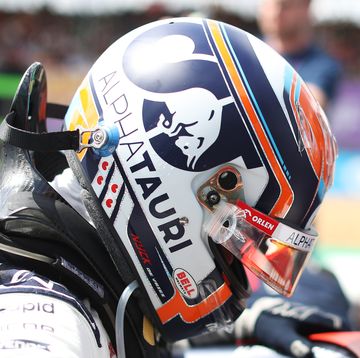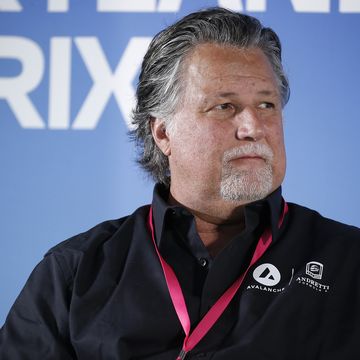Formula 1 and the FIA are set to push for a solution to its track limits debacle after a spate of penalties were issued post-race Sunday in Austria.
The order outside of the top three altered five hours after the conclusion of the race once a raft of penalties for exceeding track limits were applied.
The biggest loser was Ferrari’s Carlos Sainz, who dropped from fourth to sixth due to the application of a 10-second time penalty, elevating McLaren’s Lando Norris and Aston Martin’s Fernando Alonso.
Mercedes pair Lewis Hamilton and George Russell traded positions, with the younger Briton moving up to seventh at his teammate’s expense, while Lance Stroll displaced Pierre Gasly for ninth.
Those outside of the top 10 – who do not score points anyway – were also shuffled around due to a spate of penalties.
It was an unedifying conclusion to a race that was dominated by talk of track limits.
What happened to make it this bad?
The issue has arisen in past seasons at the Red Bull Ring and the main points of concern are the two medium-speed right-handers that conclude the lap: Turns 9 and 10.
The trajectory of the cars, combined with a compression into Turn 10, pitches drivers across the wide curbs that separate the track edge from the run-off area.
The situation is also accentuated at the Red Bull Ring by the short nature of the lap prompting drivers into trying to search for every thousandth of a second.
Up until recently drivers were allowed to use the entirety of the exit curbs, with the track limit defined as being all four wheels wide of the end of the curb. But the track limit is now defined as the end of the tarmac itself.
There were 47 timed laps deleted during qualifying when drivers exceeded track limits.
Several drivers were eliminated from either Q1 or Q2 due to timed efforts being deleted, with Sergio Perez the biggest loser, as all three of his attempts in Q2 were wiped from the board. He lined up 15th as a result, having initially set a time quick enough for second, but for running wide.
Why was it not assessed during the race?
There were breaches noted during the race and time penalties were distributed to some drivers – which were either taken during pit stops or applied once they crossed the line.
The problem for the FIA’s Race Control is it was overwhelmed by the volume of breaches, potential breaches and queries made by drivers or teams about opponents.
Due to the time involved in this, at one stage in the race a message flashed up warning Nico Hulkenberg that he was on his final strike – despite the fact he had already retired several laps beforehand.
There were a reported 1,200 cases but Autoweek understands that this figure was closer to 1,500, and these had to be assessed in order to get a clarity on the situation.
This was already ongoing at a stage when Aston Martin filed a protest of the race result due to its belief that other drivers had transgressed without incurring a sanction.
After that was completed, it was concluded that there had been 83 instances of a breach of track limits during the race.
Per the regulations drivers are allowed three ‘free hits’ before incurring a five-second time penalty, while another breach results in a 10-second sanction. This is then reset, and the counting of infringement restarts, meaning another penalty follows for a further four breaches and so on.
After the race notifications of the penalties were duly distributed, and the race order reshuffled and finalized.
What to the drivers think?
Drivers were in broad agreement that the situation makes them look silly and as a TV spectacle it does not exactly convey Formula 1 as the pinnacle of motorsport. Did someone go slightly wide? Come back in five hours to find out!
“If you saw the amount of lap times that were getting deleted by the amount of drivers it’s clearly not that easy,” said Max Verstappen, speaking after qualifying. “I don’t think we’re all idiots out there, right?”
Added Charles Leclerc: “This track is particularly tricky, especially Turn 10, because the nature of the corner is that the car is getting lighter in the middle of the corner, because there’s this drop in the track. From where we are, so low in the car, we cannot see anything, so we are not seeing all the white lines.”
Neither Verstappen nor Leclerc incurred a penalty in the race, while McLaren’s Lando Norris was another to escape sanction, and he too had sympathy while suggesting a straightforward solution.
“To stay ahead of a quicker car, which has got DRS, you’re pushing like this in every single corner,” said Norris. “You have one little snap and the wind changes and through the corner you can end up off the track. The fact you get penalized is a bit of a nasty thing, it’s easy to understand, of course it makes us look a bit silly from the outside, it’s also life, rules, we have to stick to it.”
Norris is correct – the way to avoid a repeat is for drivers to stop going wide. But this is elite sport, and limits are pushed wherever possible.
Is there a solution?
Austria signed a three-year extension with Formula 1 on Sunday, on top of an earlier four-year deal, meaning it will be on the calendar through at least 2030.
In the past more substantial curbs were tested at the respective corners but these were unpopular for two reasons:
- In the case of a driver losing control there was a risk of a bigger accident if the car struck the more aggressive curbs at an awkward angle.
- The aggressive nature of the curbs also caused floor and wing damage to the cars, impacting performance, leading to teams incurring unnecessary costs for repairs or fresh components.
The most obvious solution is a gravel trap at the corner.
It was recommended by Formula 1 Race Director Niels Wittich after the 2022 Austrian Grand Prix, while his predecessor, Michael Masi, also made such a request. The FIA is expected to make a renewed push once more.
However, the circuit has so far deemed this immutable due to the presence of MotoGP at the track, and they have resisted calls for gravel to be placed at the exit of the corners on account of its safety requirements.
Other sports use technology, such as goal-line sensors in soccer or Hawkeye in tennis, but there is not the infrastructure in place to use this at the Red Bull Ring.
Various parties are nonetheless in agreement that a revision to the situation is needed before Formula 1 returns to Austria for the 2024 grand prix.
















